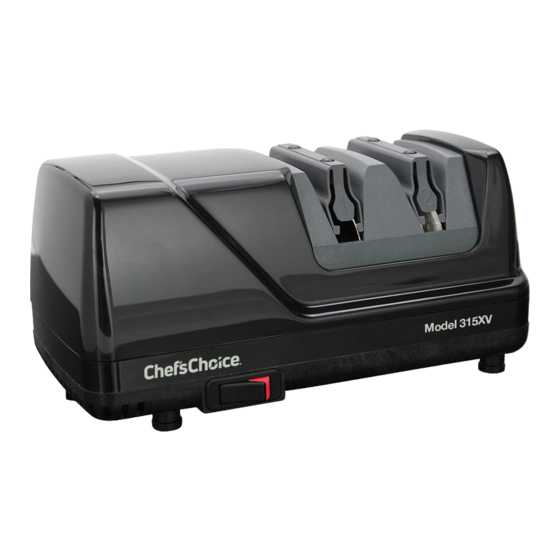
Summary of Contents for Chef'sChoice 315XV
- Page 1 Model 315XV Sharpener For Contemporay European, American and Asian Style Knives (15° Edges) Read these instructions before use. It is essential that you follow these instructions to achieve optimum results. © 2016 EdgeCraft Corp.
-
Page 2: Important Safeguards
14. Appliance is not intended to be used or cleaned by children or persons with reduced physical, sensory or mental capabilities or lack of experience and knowledge of the hazards involved. 15. Do not use honing oils, water or any other lubricant with the Model 315XV. 16. For household use only. SAVE THESE INSTRUCTIONS. - Page 3 15 degrees became popular. Within the last few years most popular European and American brand knives converted to 15 degree edges. The Model 315XV Asian Sharpener designed with the latest sharpening, polishing and stropping technology from Chef’sChoice gives you a precision sharpener that can quickly restore your contemporary 15°...
- Page 4 (Bevel A. See page 9, Figure 9b for further details). The Model 315XV is equipped with a manually actuated diamond dressing pad that can be used, if necessary, to clean any accumulated food or sharpening debris from the ultrafine abrasive surface of the Stage 2 polishing/stropping disks.
- Page 5 Figure 2. Santoku knife in left slot Stage 2 (double facet Figure 3. Santoku knife in right slot of Stage 1. Santoku blade). b. If there is no burr continue honing in Stage 1, alternating left and right slots until a light burr develops. When a burr is present along the entire blade length proceed as below to polish again in Stage 2.
- Page 6 Note: Do not attempt to sharpen any traditional blade thicker than inch (3 mm) in the Model 315XV sharpener. (Control of the sharpening angle becomes difficult for such thick blades.) Again confirm which side of the blade has the large factory Bevel A. Hold the blade in your hand (as if you are cutting) and if the large factory bevel is on the right side of the blade, the blade is right handed.
- Page 7 The Model 315XV sharpener will restore the pointed teeth of the serrations, which do most of the cutting, and develop sharp microblades along the edge of these teeth.
- Page 8 If the serrated edge is extremely worn or severely damaged, then the knife should first be pre-sharpened in Stage 1. In this stage only sharpen the non-grooved side of the serrated blade, as follows: If the grooved serrations are on the right side of the blade (as you would hold the knife when cutting), then only use the right slot of Stage 1.
- Page 9 c. Check the blade for sharpness. For a sharper edge make a few more pairs of fast pulls as in step b and check for sharpness. re-SharpenIng the tradItIonal 20° euro/amerICan Blade Re-sharpen in Polishing Stage 2 as described above. You will be able to re-sharpen repetitively about 5-10 times using only Stage 2 as described above.
- Page 10 Figure 10. Cross-section of a typical factory traditional Asian knife edge, magnified 50x (right-handed). dreSSIng of StroppIng/polIShIng dISK — Stage 2 The Model 315XV is equipped with a built-in accessory to manually clean/dress the strop- ping/polishing disks in Stage 2. In the event...
- Page 11 ® 6. To increase your proficiency with the Chef’sChoice Model 315XV, learn how to detect a burr along the edge (as described on page 5). While you might be able to sharpen well without using this technique, it is the best and fastest way to determine when you have sharpened sufficiently in the preliminary steps.
-
Page 12: Normal Maintenance
normal maIntenanCe NO lubrication is required for any moving parts, motor, bearings or sharpening surfaces. There is no need for water on abrasives. The exterior of the sharpener may be cleaned by carefully wiping with a soft damp cloth. Do not use detergents or abrasives.





Need help?
Do you have a question about the 315XV and is the answer not in the manual?
Questions and answers